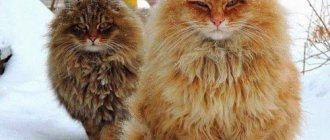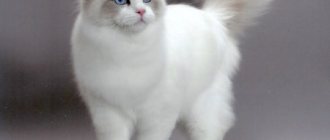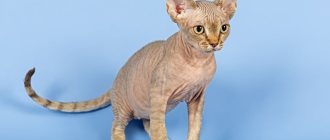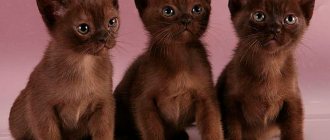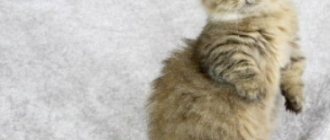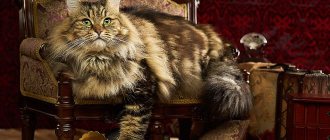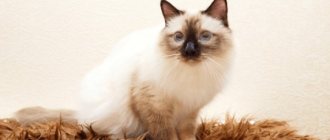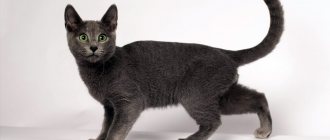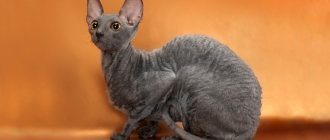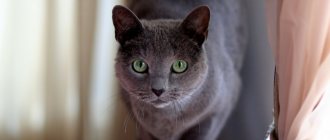History of the breed
The Siberian cat is a phenomenal breed. On the one hand, it has been known for a very long time, not only in Russia, but also abroad. Cats in Russian folk tales are probably of the Siberian breed. In classical literature there are also descriptions of cats indicating their Siberian origin.
These cats took part in shows in England and New York in the 19th century and are mentioned or depicted in books about cat breeds published in 1889, 1898 and 1900. But breed standards were officially recognized only in 1990.
When Russian felinologists (and the first were breeders from Moscow and Leningrad) began work on breeding a national cat breed in 1986, they wanted to call it “Moscow semi-longhair”. But since they took as a basis the type that was popularly associated with Siberian origin, this is how the Siberian cat was named.
Table: main stages of breed development
| 1986 | Start of work of the Leningrad and Moscow clubs. In the surviving journals, a few cats of the “Siberian type” are registered. |
| 1987 | The first cat show in the USSR in Moscow Bitsa. All fluffy cats are recorded as Siberians. At the exhibition, magnificent specimens of phenotypic Siberians were selected for the development of standards. |
| 1987–1988 | The first preliminary standards for Siberian cats have appeared |
| 1988 | Six newcomers of unknown origin of the same agouti color are assessed as Siberian phenotypic |
| 1990 |
|
| 1992 | The World Felinological Organization (WCF) has recognized the Siberian cat breed and registered its standard |
| 1994 |
|
| 1996 |
|
| 1997 | At the coordination meeting of felinological associations and clubs of the CIS, the standard of Siberian cats was supplemented and approved in order to finally have a clear idea of the difference between the Siberian cat and the Maine Coon and Norwegian Forest |
| 1997 | The Siberian breed is recognized in the European International Association (FIFe) |
| year 2000 | 33 Siberians become world champions, and 12 foreign countries open Siberian catteries |
Currently, unfortunately, Siberian cats are more popular abroad. The reluctance to purchase purebred animals in their homeland is explained mainly as follows: “Why spend money if I can pick up the same one in the backyard.”
As I see it, the breeders themselves are largely to blame for the current situation. The vast majority of people who get a Siberian-type cat want it to be not just a pet, but also to do the natural work of a cat, that is, to catch mice and rats. The Siberian is a good natural hunter, who is also adapted to life in a harsh climate. But instead of promoting the working qualities of the breed, some breeders immediately stipulate that they will not give their kittens to a private free-range home. That is, they are trying to create another “couch cushion” out of a good working animal. It’s like with dogs - there was a brave dog, a brave fighter against rats, but it became a symbol of glamor (I’m talking about the Yorkshire terrier).
Description of appearance and standards
Siberian cats are quite large animals. Females of this breed weigh up to six kilograms, and males - up to twelve. But they are very mobile and have good jumping ability due to the fact that their hind legs are slightly longer than their front legs.
Siberian cats are quite large and powerful animals.
The Siberian fur coat is beautiful and practical. A distinctive feature is the frill and panties. Their coat is of medium length and has a dense undercoat, which helps the animal feel quite comfortable even in severe frosts. The body is muscular and strong, making the Siberian cat an excellent hunter.
Siberians belong to the “forest type” along with the Norwegian forest cat and Maine Coon. And if at first glance these animals are similar, then upon closer examination each will have its own characteristics. For example, the head of a Maine Coon has angular lines, it seems to be made up of several boxes, in a Norwegian the transition from the forehead to the muzzle is practically not pronounced, a kind of straight line, and in a Siberian the profile is smoother compared to the Maine Coon, but the transition from the forehead towards the muzzle is more clearly expressed than in the Norwegian Forest.
Forest type cats have significant differences in head structure
A common feature of “forest type” cats can be the so-called wild color (various agouti, including white, as well as brindle, spotted and marbled). But recently, breeders have become interested in breeding Siberian cats of all kinds of colors (since they are more in demand among exotic lovers), so after looking at the offers of different breeders, I got the impression that soon the ordinary “mustachioed-striped” will be considered exotic.
Table: SFF Siberian breed standard (adopted in 1990)
| general characteristics | Strong, massive, muscular animals of large and medium size. Cats are much smaller than cats. |
| Head | Short wide trapezoid shape in good proportion to the body. The top of the head is flat. A smooth transition from a low forehead to a wide, straight bridge of the nose. The nose is of medium length without stop or snub. Cheekbones are low, cheeks are full. Strong jaws. The chin is wide, fairly strong, but not protruding. |
| Neck | Strong, short |
| Ears | Medium size, wide at the base, spaced at a distance greater than the width of one ear at the base. The outer line of the ear is vertical, the outer edge of the ear is located slightly above eye level. The ears are slightly tilted forward. The ends are rounded. Brushes and brushes are desirable. |
| Eyes | Large and medium-sized, rounded, set wide and slightly oblique |
| Eye color | Green or yellow of all shades, evenly colored. Color-point (Neva Masquerade) and white cats have blue eyes. Disagreement in the colors “van” and “white”. |
| Type | Strong, massive |
| Body | Dense, massive, with prominent muscles, of medium length on strong short limbs. The paws are large and round. Tufts of fur between the toes. |
| Tail | Wide and strong at the base, almost reaching to the shoulder blades. Well pubescent, ending bluntly. |
| Wool | The outer hair is hard, shiny, water-repellent, lengthening from the shoulder blades to the croup, descending to the sides and upper part of the tail. On the sides the coat is softer, loosely fitting, and very dense. The undercoat is double, depending on the season: light, short, close-fitting in summer, abundant in winter, long, very thick and dense, with excellent texture. The decorative coat is long but dense, in the form of a mane, full collar and frill. Lush “pants” and a perfectly bushy tail. Short hair on paws. During seasonal molting, almost nothing remains of the decorating fur. |
| Colors | All are allowed except lilac, chocolate, abi, all “agouti” and “tabby”, which have a more characteristic coat texture, are preferred. Cats of “color-point” and “color-point with white” colors are called “Neva Masquerade” (“Siberian color-point”). |
| Condition | Healthy, strong, robust, well-groomed cat |
| Flaws |
|
| Crossbreeding | Crossing with other breeds is not allowed |
There are slight differences in the breed standards of different felinological federations.
Peculiarities
You should familiarize yourself not only with the character of the Siberian cat, but also with the breed standards. Features include the fact that it is a large, muscular animal with a powerful torso. His body is heavy, his neck is short, and his lamps are compact. Between the paws there are long tufts of hair.
Cats have a small head, the cheekbones are low, and the forehead is slightly pushed forward. The animal's nose is smooth and wide. The eyes are oval-shaped, slightly slanted. The ears are medium in size and slightly tilted forward. Cats have a wide and bushy tail that hangs evenly down.
These cats have a magnificent fur coat. Since they live in Siberia, they have acquired characteristic features. Long hair is the pride of the breed. Thanks to their thick undercoat, the animals are fluffy and can withstand severe frosts. The cat captivates with its natural beauty and grace.
Character of the Siberian cat
At first glance at a Siberian cat, you may get the impression that this is a stern animal with a wild character. But that's not true. They are kind, friendly and can be excellent companions, at the same time they are very delicate - always nearby, but not intrusive, and if you have the time and desire, they will play with you with pleasure. A representative of the Siberian breed is wary of strangers, but only until he gets used to a new person.
Siberians are distinguished by their loyalty both to people and to each other. Thus, male cats of this breed can create stable unions that last until the death of one of the partners. At the same time, Siberian cats help cats take care of their offspring.
Cats of the Siberian breed love to move “on top”, so for an animal living in an apartment, you should provide this opportunity, that is, equip a kind of obstacle course and beds located as high as possible so that your pet can observe order in its territory. The Siberian's muscular body is very flexible, so he rarely drops or breaks any objects.
Representatives of this breed are not at all afraid of water.
Siberian cats get along very well with all family members, including dogs, but it is better to keep poultry and rodents out of reach. Of course, the cat understands that these particular individuals cannot be hunted, but he cannot always control his instincts. So don't be careless and try to prevent tragedy.
Siberian cats get along well with children, but still try to ensure that a too small child does not pester the animal or hurt it.
Despite their rich coat, Siberians are considered hypoallergenic.
Video: features of the Siberian breed
Métis
A well-known mixed breed is the Neva Masquerade - a Siberian with the coloring of a Siamese. This is a beautiful animal with thick fur. These cats are loved for their original appearance and serious character.
There is also a cross between a Siberian and a fold breed. The pets are original in that the type has drooping ears and facial features of a Scottish cat, and the fur comes from a Siberian cat.
There are also Persian mestizos. Due to the fact that Siberian cats are similar to Persians with a thick collar and panties, these breeds are not related. Often, unscrupulous breeders cross the popular Persian breed with the Siberian breed to produce mass offspring similar to Siberians.
Health of Siberian pets
Siberian cats are long-lived. Their average life expectancy is 17 years, although this figure often reaches 20 years or more.
Hereditary pathologies
Despite the good health of these animals, the risk of developing genetic diseases cannot be completely excluded. Siberians have at least one dangerous hereditary problem - the likelihood of hypertrophic cardiomyopathy.
Hypertrophic cardiomyopathy (HCM) is the most common form of heart disease in cats. It causes thickening (hypertrophy) of the heart muscle. An echocardiogram can confirm whether a cat has this condition.
Hypertrophic cardiomyopathy consists of thickening of the walls of the heart ventricles, due to which the organ cannot function properly
Avoid breeders who claim that their lines are free of HCM. No one can guarantee that their cats will never have such a pathology.
Siberians that are intended to breed should be tested for HCM. If the diagnosis is confirmed, animals should be excluded from breeding programs. Do not buy a kitten whose parents have not been tested for this disease.
Hip dysplasia is another inherited disease that is common in large cats. This pathology can be combined with a dislocation of the knee joint. The disease can occur in different forms:
- mild - subluxation with slight displacement of the joint;
- severe - degeneration of the joint.
In general, with dysplasia, there is a loss of correspondence between the articular surfaces, which leads to dislocation or arthrosis. At the same time, cats experience pain, begin to limp, try to move less, and when walking they begin to “wiggle their butts.” Gradually, the femoral muscle group atrophies.
Hip dysplasia is a severe hereditary pathology in cats.
This disease is easier to prevent than to cure. Therefore, large cats should receive a special vitamin complex; it is better to consult a veterinarian about its composition.
Other diseases
More than 40% of domestic cats are overweight. Unfortunately, we have long had a “national” stereotype of beauty in relation to pets - the fatter the cat, the better. Meanwhile, excess weight can cause or accelerate the development of many diseases in cats:
- type 2 diabetes and other endocrine disorders;
- urolithiasis;
- liver diseases;
- diseases of the skin and pancreas (pancreatitis);
- joint diseases.
Siberians who lack physical activity are prone to rapid weight gain.
Siberians, like other long- and semi-long-haired cats, may experience intestinal blockage, the cause of which is hair that gets into the digestive tract. Therefore, help your cat care for its fur coat. Once every two months you can give your pet a special paste to cleanse the intestines of hair. But the best option is fresh grass. If a cat has the opportunity to “graze” while walking, then she will find the plants she needs on her own. And if your pet lives in an apartment, then you can grow grass on the windowsill.
Cat grass can be grown on a windowsill to cleanse the digestive tract of fur.
It should still be noted that in general, Siberian cats are quite strong and healthy animals.
Lifespan
Life expectancy depends on various factors. This is influenced by heredity. Since the ancestor of Siberians was the Bukhara breed, the animals will have strong immunity. Pets are also hardy and resistant to diseases. On average, a cat lives 15-17 years, but sometimes there are long-livers - more than 20 years.
It is necessary to contact a veterinarian in a timely manner and not self-medicate. It is also important to monitor his behavior. If an active animal suddenly does not want to play or eat, you should contact a veterinary clinic.
How to choose a kitten
If you want to get yourself a purebred Siberian kitten, contact reliable breeders. This is the only way you can be sure that you will get a healthy animal that meets breed standards. The cost of kittens varies individually, but usually starts at four thousand rubles.
It may be possible to purchase a purebred Siberian much cheaper. For example, often breeders want to keep a kitten with outstanding characteristics for breeding and give it away for a purely symbolic sum in co-ownership, but in this case you undertake the obligation to take part in the breeding work of the nursery. Breeders also send animals to other homes that are no longer used for breeding.
As a rule, breeders raise kittens up to four months and sell them already vaccinated, and some even sterilized. But these are already teenagers with all the physical charms of this age - angular and disproportionate. Therefore, it is better to look at photographs, or even videos, of your kitten at an earlier age. Conscientious breeders will be happy to provide you with such materials.
Siberian kittens grow and develop very slowly; they are fully formed only by the age of three to five years. Therefore, it is difficult to determine by the appearance of the baby what he will look like as an adult. Feel free to ask for all possible photographs of his other relatives. In principle, you can do this yourself, because most breeders have their own websites on which this information is presented.
A good Siberian kitten should have powerful paws, a wide chest, and strong bones. The eyes should not be too round, but slightly elongated. It is desirable, but not necessary, to have tassels on the ears; it is quite possible that they will appear later. It’s good if the kitten’s nose is wide and does not narrow from the bridge of the nose to the earlobe. A wide chin is also preferred, and its line should be level with the line of the nose. A harmonious and smooth transition from the forehead to the nose should not be abrupt, but still well defined.
A good Siberian kitten should have powerful paws, a wide chest, and strong bones.
The temperament of the kitten you purchase is important, and it must match yours. Also keep in mind that not only you choose your pet, but he also chooses you. Watch how he reacts to you, how quickly he gets used to it, hold him in your arms, play. And only then make the final choice.
Our advice
A Siberian cat kitten can be weaned from its mother at the age of 3 months. By this time, the animal will learn to lap up food from a saucer, use a tray, and acquire the necessary skills to communicate with other representatives of the animal world.
According to user reviews, the character of the Siberian cat changes slightly over time, so pay close attention to the behavior of the small animal. If the pet is active and cheerful, you are lucky - the cat will be a wonderful pet.
But it is better to avoid purchasing lethargic and timid kittens; infantile fear can cause aggression and unsociability at an older age.
When choosing a baby in a nursery, focus on health certificates, check information about vaccinations performed and check that the documents are filled out correctly. And when buying a cat remotely, be sure to ask for a photo of a Siberian cat in order to at least visually assess the animal’s compliance with the breed.
Based on materials: murlo.org, kot-pes.com, murkote.com, zootovary.com, zoobusiness.kiev.ua, veterinariya.info, murlika.msk.ru
How to care for a Siberian cat
Although the Siberian cat has long hair with a thick undercoat, it does not require special care, and the animals, famous for their cleanliness, can handle grooming themselves. The structure of the wool is such that it does not roll into tangles. All you have to do is brush your cat once a week. During the period of active molting, this should be done more often - two to three times a week.
To care for a Siberian cat, a simple set of tools is enough.
You may need to keep your cat clean under the tail, as there may be clumps of feces or bits of litter on your cat's fluffy pants.
Siberians are not afraid of water; some of them enjoy playing with it or even love water treatments. But this does not mean that they need to be washed frequently, especially with detergents. Do this only in case of severe contamination, and then, if possible, with plain clean water.
Cats need to have their eyes rubbed, their ears inspected and cleaned if necessary.
The author is an ardent opponent of trimming cats' claws, so he will never recommend this procedure. The cat does not need it at all, and if you are afraid that the animal will scratch the furniture or you, teach it not to do this. Cats are very intelligent creatures. People in general understand animals very slowly and with difficulty: human animals are much faster and more subtle. A scratching post will be a great way out of this situation.
If you purchased a kitten from a reliable breeder, then it will already be litter box trained. Moreover, some breeders try to introduce kids to different litters for the toilet. In any case, ask what kind of filler the kitten is used to. If you are not satisfied with something about him, retrain your pet gradually so that he does not refuse to go to the litter box.
Siberians are large cats, so you need to select an appropriate tray for them, preferably with high sides.
Some cats prefer a closed litter box, but in the case of Siberians, its use can be problematic, since, firstly, the cat must fit comfortably in the litter box, which means it must be quite large, and secondly, a large closed cat litter box requires a lot places. But you can make it from an old bedside table. It’s only better in this case to provide it with a waterproof coating inside.
An indoor toilet for a large cat can be made from a nightstand
Feeding
Siberians do not have any special breed characteristics regarding food. Therefore, it is important to consider the following basic recommendations:
- feed the animal high-quality food;
- Don't let us overeat;
- Do not offer foods that can harm the cat.
A cat's diet should be varied and balanced. The cat is a carnivore, and the best food for it is natural prey caught during the hunt - a mouse. The mouse consists of high-quality, perfectly balanced ingredients: protein, fats and carbohydrates. It contains many minerals, the liver is rich in vitamins, and the bones are rich in calcium. Unfortunately, few of us are able to provide our cat with such nutrition. But it is quite possible to compensate for it with other products.
The best food for a cat is a natural, hunted prey - a mouse.
All cats should not be given the following foods:
- bird bones and cattle rib bones (they can cause intestinal perforation);
- fatty foods;
- raw river fish;
- any sweets, culinary products, baked goods;
- any pickled, salted, canned foods, including herring;
- fried foods (meat, fish);
- potatoes in any form, peas, beans;
- sausages and smoked meats;
- stale food.
Nowadays there are many ready-made foods available on the market. Of course, it is easier to feed animals with them, but not always better. Preference is given to ready-made food, as a rule, because there is no opportunity or desire to tinker with natural products.
In terms of price, the difference is small, since high-quality industrial feeds based on meat, fish, offal and grains are expensive.
The cat should eat with appetite and not leave food in the bowl.
Siberians, as already mentioned, with insufficient activity can be prone to obesity. Therefore, you should adhere to the following rules:
- Feed the animal twice a day.
- Remember that only a healthy animal with normal food interest can eat exactly as much as it needs when given unlimited access to food. Therefore, it is better to limit this access.
- If the cat does not finish its portion, it means that it is already full. In this case, you should reduce the serving size.
- The cat should eat with appetite. If this does not happen with the usual food, there are two options - the cat is overeating or is sick. Watch her, if no one feeds her, then show the animal to the veterinarian.
- New food is introduced into the diet gradually, since cats are very conservative and may not immediately appreciate it. This is especially true for the transition from ready-made feeds to natural ones.
Breeding work
Thanks to the natural data, Siberian cats do not experience problems in reproduction. Thus, cats are ready for reproduction from the age of five months, and cats at seven to eight months. They retain this function until old age.
Cats usually cope well with pregnancy and childbirth themselves. They may need help only if problems arise with labor, but this is rare.
A litter of Siberian cats usually contains five to six kittens. But sometimes, if the kittens are very large, there may be two or even one baby. By the way, it is in this case that the help of a veterinarian during childbirth may most often be required. Sometimes very large litters occur - up to nine kittens.
Siberian cats are very caring mothers. They require virtually no help in the first month of the kittens' life, then, of course, you will need to introduce complementary foods and switch the babies to an independent diet (if you are going to be a responsible breeder and raise them up to four months).
Siberian cats are very caring mothers
If you want to have kittens from your purebred pets, you need to know and follow certain rules:
- Crossing Siberian cats and cats with other breeds is prohibited.
- If you are the owner of a pet-class animal, you are obliged to ensure its sterilization. Such individuals are not allowed for breeding.
- The animal must be fully formed, so it is better to start breeding it no earlier than one year of age.
- To get good offspring and maintain the health of the cat, you should not breed animals older than five to six years.
- One pregnancy per year is possible for a cat (if, of course, you care about her health).
Animals that are not suitable for breeding or have reached a certain age must be sterilized. Since Siberians are prone to heart problems (like all large cats), it is necessary to pay increased attention to the health of neutered cats. A proper diet and sufficient physical activity will help to avoid this problem, since the main cause of heart disease is not castration itself, but obesity, which can arise from it.
Many breeders sell kittens already sterilized.
Hygiene
Cats that do not leave the house should be bathed no more than once a year. An animal that is taken for a walk should be bathed once a quarter. Cotton swabs are placed in the ears to prevent water from entering. Place a non-slip mat or towel on the bottom of the container. Shampoo-conditioners that are used for long-haired cats are used for washing. After bathing, dry the wool with a towel or hair dryer.
The pet's eyes should be wiped with cotton swabs or a clean napkin when discharge occurs. The ears are examined regularly. If you need to clean from wax and dirt, you need cotton swabs moistened with a special lotion. To cleanse teeth and mouth from plaque, toothpastes are used. It is periodically required to use preventative treats. Almost no nail trimming is required, so a standard scratching post is needed. Thanks to high-quality hygiene, the animal will always be happy.
